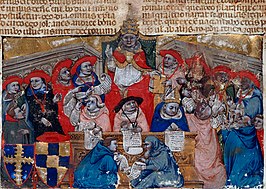Our website is made possible by displaying online advertisements to our visitors.
Please consider supporting us by disabling your ad blocker.
Papal primacy

| Papal primacy, supremacy and infallibility |
|---|
Papal primacy, also known as the primacy of the bishop of Rome, is an ecclesiological doctrine in the Catholic Church concerning the respect and authority that is due to the pope from other bishops and their episcopal sees. While the doctrine is accepted at a fundamental level by both the Catholic Church (Eastern and Western) and the Eastern Orthodox Church, the two disagree on the nature of primacy.
English academic and Catholic priest Aidan Nichols wrote that "at root, only one issue of substance divides the Eastern Orthodox and the Catholic Churches, and that is the issue of the primacy."[1] French Eastern Orthodox researcher Jean-Claude Larchet wrote that, together with the Filioque controversy, differences in interpretation of this doctrine have been and remain the primary causes of schism between the Catholic Church and the Eastern Orthodox Church.[2] In the Eastern Orthodox churches, some understand the primacy of the bishop of Rome to be merely one of greater honour, regarding him as primus inter pares ("first among equals"), without effective power over other churches.[3] A prominent 20th century Eastern Orthodox Christian theologian, Fr. Alexander Schmemann, envisioned a primacy that sums up rather than rules over: "Primacy is power, but as power it is not different from the power of a bishop in each church. It is not a higher power but indeed the same power, only expressed, manifested, and realized by one." [4]
The Catholic Church attributes to the primacy of the pope "full, supreme, and universal power over the whole Church, a power which he can always exercise unhindered,"[5] a power that it attributes also to the entire body of the bishops united with the pope.[6] The power that it attributes to the pope's primatial authority has limitations that are official, legal, dogmatic, and practical.[7]
In the Ravenna Document, issued in 2007, representatives of the Eastern Orthodox Church and the Catholic Church jointly stated that both accept the bishop of Rome's primacy at the universal level, but that differences of understanding exist about how the primacy is to be exercised and about its scriptural and theological foundations.[8]
- ^ Nichols 2010, p. 313.
- ^ Larchet 2006, p. 188.
- ^ Speciale 2011.
- ^ Schmemann 1995, p. 165.
- ^ Catechism of the Catholic Church (2nd ed.). Libreria Editrice Vaticana. 2019. Paragraph 882.
- ^ Catechism of the Catholic Church (2nd ed.). Libreria Editrice Vaticana. 2019. Paragraph 883.
- ^ Phan 2000, pp. 486–488.
- ^ Ravenna Document 2007, nn. 43–44.
Previous Page Next Page


